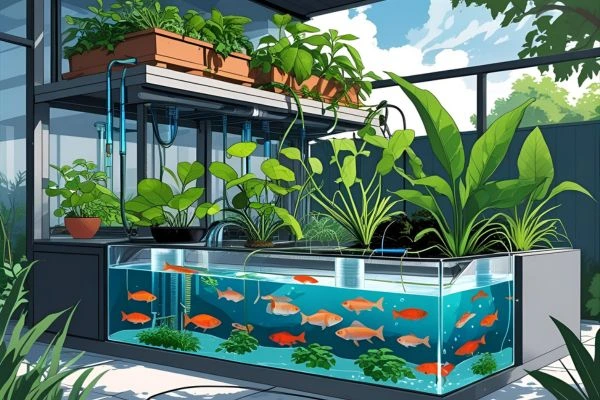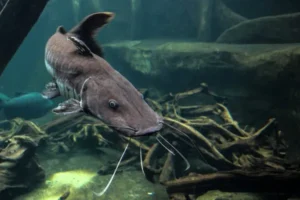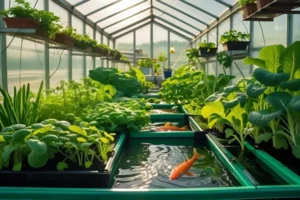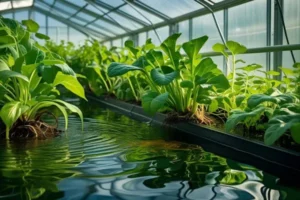Imagine producing 10 times more food per square foot while using 90% less water than traditional farming—this isn’t science fiction, it’s the reality of learning how to grow aquaponics successfully. The global aquaponics market is exploding, growing at 12.3% annually and projected to reach $1.8 billion USD by 2027, as more people discover this revolutionary food production method.
Traditional agriculture faces mounting challenges: soil depletion affects 33% of global farmland, water scarcity threatens 40% of the world’s population, and urbanization eliminates 24 million acres of farmland yearly. Meanwhile, food prices continue rising 3% to 8% annually, pushing families toward expensive, often pesticide-laden produce shipped thousands of miles.
What if you could grow aquaponics in your backyard, basement, or greenhouse and harvest fresh fish and vegetables year-round? This sustainable system combines aquaculture (fish farming) with hydroponics (soilless plant growing), creating a closed-loop ecosystem where fish waste fertilizes plants, and plants purify water for fish.
Whether you’re a complete beginner seeking food security, an urban dweller with limited space, or an entrepreneur exploring commercial opportunities, learning to grow aquaponics offers unprecedented control over your food supply. This comprehensive guide delivers everything you need: from selecting the right components and fish species to managing daily operations and troubleshooting common challenges.
Ready to transform empty space into a thriving food production system? Let’s dive into the fascinating world of aquaponics and discover how you can start growing fresh, organic food within 30 to 60 days.
What is Aquaponics and Why Grow It?
Definition and Basic Principles
Aquaponics is a sustainable food production system that combines aquaculture (raising fish) with hydroponics (growing plants without soil) in a symbiotic environment. When you grow aquaponics, you’re essentially creating a miniature ecosystem where beneficial bacteria convert fish waste into plant-available nutrients.
The process works through the nitrogen cycle: fish produce ammonia-rich waste, beneficial bacteria (Nitrosomonas and Nitrobacter) convert ammonia to nitrites then nitrates, plants absorb these nutrients through their roots, and clean water returns to fish tanks. This closed-loop system requires 90% less water than soil gardening while producing both protein and vegetables simultaneously.
Environmental and Economic Benefits
Growing aquaponics delivers remarkable environmental advantages. Systems use 95% less water than traditional farming through recirculation, eliminate agricultural runoff that pollutes waterways, and require zero pesticides or herbicides. Carbon footprint reduction reaches 60% to 80% compared to conventional agriculture, especially when you grow aquaponics locally.
Economically, home systems producing 200 to 400 pounds of vegetables and 50 to 100 pounds of fish annually save families 1,500 to 3,000 USD yearly on grocery bills. Commercial operations achieve 8 to 12 USD per square foot annually—triple the revenue of traditional farming.
Comparison with Traditional Gardening
Traditional gardening faces significant limitations: soil quality degradation, weather dependency, pest management challenges, and seasonal restrictions. When you grow aquaponics indoors, you control temperature, lighting, and nutrients year-round, achieving 4 to 6 harvest cycles annually versus 1 to 2 outdoor cycles.
Space efficiency dramatically favors aquaponics: vertical growing systems produce 10 to 15 times more food per square foot. Setup costs range from 3,000 to 8,000 USD for comprehensive home systems, but payback periods average 2 to 4 years through food savings and potential sales of surplus produce.
Essential Components to Grow Aquaponics Systems
Fish Tank and Grow Beds
The foundation to grow aquaponics successfully starts with properly sized tanks and grow beds. Fish tanks should provide 5 to 10 gallons per pound of mature fish weight—a 100-gallon tank supports 10 to 20 pounds of fish (approximately 15 to 25 tilapia). Food-grade polyethylene or fiberglass tanks (200 to 800 USD) resist UV degradation and maintain water quality better than repurposed containers.
Grow beds require 1 to 2 square feet of growing space per pound of fish. Standard depths range from 8 to 12 inches, filled with expanded clay pebbles (40 to 80 USD per 50-liter bag) or gravel substrate. The ideal fish tank to grow bed ratio is 1:1 to 1:2 by volume—a 100-gallon fish tank pairs with 100 to 200 gallons of grow bed capacity.
Water Circulation and Filtration
Reliable water pumps circulate 3 to 5 times the tank volume hourly. A 100-gallon system needs pumps moving 300 to 500 gallons per hour, consuming 50 to 150 watts continuously (15 to 45 USD monthly electricity). Submersible pumps (80 to 300 USD) offer quiet operation, while external pumps provide easier maintenance access.
Biological filtration occurs naturally in grow beds, but mechanical filters (50 to 200 USD) remove solid waste before water reaches plants. Aeration systems maintain 5 to 8 ppm dissolved oxygen through air pumps (20 to 100 watts) and air stones, preventing fish stress and supporting beneficial bacteria colonies.
Monitoring Equipment
Essential monitoring tools include digital pH meters (30 to 150 USD) for maintaining 6.8 to 7.2 pH levels, ammonia test kits (15 to 40 USD) for cycle monitoring, and thermometers (10 to 50 USD) ensuring 70°F to 80°F water temperatures. Timer systems (20 to 100 USD) automate feeding and lighting cycles, while backup power supplies (200 to 800 USD) protect systems during outages.
Step-by-Step Guide to Grow Your First Aquaponics System
Planning and Site Preparation
Before you grow aquaponics, select a location receiving 6 to 8 hours of sunlight daily or install LED grow lights (30 to 50 watts per square foot). Indoor spaces need 60°F to 85°F ambient temperatures, adequate ventilation, and access to electrical outlets supporting 200 to 500 watts continuous load.
Calculate your space requirements: a starter 50-gallon fish tank with 100-gallon grow bed footprint needs approximately 4 feet by 8 feet floor space. Ensure structural support for water weight—filled systems weigh 8 to 12 pounds per gallon. Budget planning for basic setups ranges from 1,500 to 4,000 USD including tanks, pumps, media, and initial fish stock.
System Assembly and Setup
Start with tank positioning: place fish tank 12 to 18 inches below grow beds for gravity-fed drainage. Install pump systems to move water from fish tank to grow beds, then gravity-return through standpipes or bell siphons. Plumbing connections use 1-inch to 2-inch PVC pipes with unions for easy maintenance access.
Fill grow beds with pre-rinsed expanded clay pebbles or gravel, ensuring 2 to 3 inch clearance above media for root development. Install aeration systems with one air stone per 50 gallons of fish tank volume, powered by pumps providing 1 to 2 watts per gallon.
Initial Cycling Process
Fishless cycling establishes beneficial bacteria colonies over 4 to 6 weeks. Add ammonia source (fish food or pure ammonia) maintaining 2 to 4 ppm ammonia levels. Test water weekly—ammonia peaks at week 2, nitrites peak at week 3 to 4, then both drop to near zero as nitrates rise, indicating cycle completion.
Adding Fish and Plants
Stock fish gradually: start with 25% of planned fish density, adding remaining fish over 2 to 3 weeks. Tilapia fingerlings (2 to 4 inches) adapt quickly, while goldfish tolerate beginner mistakes better. Plant leafy greens (lettuce, spinach, herbs) immediately—they tolerate cycling fluctuations and begin producing harvests within 30 to 45 days after you successfully grow aquaponics systems.
Best Plants and Fish to Grow in Aquaponics
Beginner-Friendly Plants
When learning to grow aquaponics, start with leafy greens that thrive in nutrient-rich water and tolerate pH fluctuations. Lettuce varieties (Buttercrunch, Romaine, Red Sails) mature in 30 to 45 days, requiring minimal nutrients and producing continuous harvests through cut-and-come-again methods.
Herbs excel in aquaponics systems: basil grows 12 to 18 inches tall within 60 days, cilantro provides harvests every 3 to 4 weeks, and mint spreads aggressively (contain in separate beds). Spinach and kale tolerate cooler conditions (55°F to 75°F) and produce year-round in climate-controlled environments.
Fruiting plants require established systems with stable nutrient levels: cherry tomatoes yield 10 to 15 pounds per plant over 120 to 150 day growing seasons, while peppers produce 2 to 5 pounds per plant in 90 to 120 days.
Recommended Fish Species
Tilapia ranks as the top choice for beginners—they tolerate temperature ranges from 68°F to 86°F, reach 1 to 2 pounds in 6 to 9 months, and survive water quality fluctuations. Stock density supports 1 pound per 5 to 10 gallons when you grow aquaponics with adequate filtration.
Channel catfish thrive in cooler climates (65°F to 85°F), reach market size (1 to 3 pounds) in 12 to 18 months, and tolerate crowded conditions. Largemouth bass offer sport fishing value but require 75°F to 80°F water temperatures and longer growth periods (18 to 24 months).
Ornamental fish like goldfish and koi provide nutrients without harvesting pressure, living 10 to 30 years and tolerating beginner mistakes.
Matching Plants and Fish Requirements
Temperature compatibility ensures system success: warm-water fish (tilapia, catfish) pair with heat-loving plants (tomatoes, peppers, basil), while cool-water species (trout) match leafy greens and root vegetables. Feeding ratios of 40 to 50 grams daily per pound of fish provide adequate nutrients for 2 to 3 square feet of leafy green production when you grow aquaponics systems properly.
Daily and Weekly Management to Grow Healthy Aquaponics
Water Quality Monitoring
Daily checks maintain optimal conditions when you grow aquaponics systems successfully. Test ammonia levels using strips or digital meters—readings should remain below 0.5 ppm in established systems. Nitrite levels must stay under 1 ppm, while nitrate concentrations between 20 to 40 ppm indicate healthy nutrient cycling.
pH monitoring requires daily attention during the first 60 days, then weekly checks once stabilized. Maintain 6.8 to 7.2 pH using potassium hydroxide to raise or phosphoric acid to lower levels gradually (0.2 pH units per day maximum). Water temperature should remain within species-specific ranges—use heaters or chillers to maintain 72°F to 78°F for tilapia systems.
Weekly water testing includes dissolved oxygen (minimum 5 ppm), alkalinity (50 to 150 ppm), and total dissolved solids. Add 5% to 10% fresh water weekly to replace evaporation and maintain system balance.
Feeding and Nutrition Management
Fish feeding schedules optimize nutrient production: feed adult fish 1% to 3% of their body weight daily, divided into 2 to 3 meals spaced 4 to 6 hours apart. Young fish require 5% to 10% body weight daily for rapid growth. High-quality pellets (32% to 40% protein) ensure complete nutrition and minimize waste production.
Monitor feeding conversion rates: healthy fish convert 1.2 to 1.8 pounds of feed per pound of weight gain. Uneaten food after 15 to 20 minutes indicates overfeeding—remove excess to prevent water quality degradation.
Plant Care and Harvesting
Weekly plant inspection identifies nutrient deficiencies, pest issues, and harvest opportunities. Pruning removes diseased leaves and encourages new growth, while spacing adjustments prevent overcrowding that reduces air circulation.
Harvest timing maximizes yield: cut lettuce when leaves reach 4 to 6 inches, harvest herbs before flowering, and pick tomatoes at first color break. Succession planting every 2 to 3 weeks ensures continuous harvests when you grow aquaponics for maximum food production.
Common Challenges When You Grow Aquaponics (and Solutions)
Water Quality Issues
pH fluctuations represent the most frequent challenge when you grow aquaponics systems. Symptoms include fish gasping at surface, stunted plant growth, and bacterial imbalances. Solutions: buffer pH using crushed coral or limestone (raises pH gradually), add potassium bicarbonate for quick pH increases (1 teaspoon per 100 gallons raises pH by 0.3 units), or use phosphoric acid for decreases (5 ml per 100 gallons lowers pH by 0.2 units).
Ammonia spikes occur during system cycling or overfeeding, causing fish stress and potential death. Early detection: test water showing readings above 1 ppm ammonia or fish exhibiting red gills and lethargy. Immediate solutions: perform 25% to 50% water changes, reduce feeding by 50%, and increase aeration to support beneficial bacteria colonies. Recovery typically takes 3 to 7 days with proper management.
Fish Health Problems
Overcrowding stress manifests as aggressive behavior, poor growth rates, and increased disease susceptibility. Prevention: maintain stocking densities below 1 pound per 7 gallons for tilapia, ensure adequate dissolved oxygen (minimum 5 ppm), and provide hiding spaces using PVC pipes or plants.
Common diseases include ich (white spots), fin rot (frayed fins), and bacterial infections (cloudy eyes, sluggish behavior). Treatment protocols: isolate affected fish in quarantine tanks, increase water temperature by 2°F to 4°F for ich treatment, and improve water quality through increased water changes (10% to 15% daily for 7 to 10 days).
Plant Growth Issues
Nutrient deficiencies appear as yellowing leaves (nitrogen deficiency), purple stems (phosphorus deficiency), or brown leaf edges (potassium deficiency). Solutions: increase fish feeding by 10% to 20%, add iron chelate supplements (2 to 5 ppm), or supplement potassium sulfate (10 to 20 ppm) for comprehensive plant nutrition.
Pest management using beneficial insects (ladybugs, predatory mites) and organic sprays (neem oil diluted 1:10 ratio) when you grow aquaponics sustainably without harming fish or beneficial bacteria.
Scaling Up: How to Grow Aquaponics Commercially
Investment and Infrastructure Requirements
Commercial operations require substantial upfront investment when you grow aquaponics at scale. Greenhouse facilities cost 25 to 35 USD per square foot for basic structures, while climate-controlled environments reach 50 to 100 USD per square foot including heating, cooling, and ventilation systems.
Production systems for 5,000 to 10,000 square feet require 200,000 to 500,000 USD initial investment. This includes fish tanks (10,000 to 50,000 gallon capacity), commercial pumps (2,000 to 5,000 gallons per hour), backup generators (25 to 100 kW), and automated monitoring systems with remote alerts.
Labor requirements scale with production: 1,000 square feet needs 0.5 to 1 full-time employee, while 10,000 square feet requires 3 to 5 workers for daily operations, harvesting, and packaging. Annual operating costs including utilities, feed, seeds, and labor range from 8 to 15 USD per square foot.
Business Planning and Market Analysis
Revenue projections for established commercial operations achieve 12 to 25 USD per square foot annually. Premium markets (restaurants, farmers markets, CSA programs) pay 30% to 50% above wholesale prices for locally grown, pesticide-free produce.
Break-even analysis typically shows profitability in years 3 to 5, with payback periods of 7 to 12 years depending on market access and operational efficiency. Product diversification combining vegetables (6 to 8 USD per pound for leafy greens), herbs (12 to 20 USD per pound), and fish (4 to 8 USD per pound) maximizes revenue streams.
Market research identifies local demand: restaurants purchasing 50 to 200 pounds weekly, grocery stores requiring consistent 500 to 2,000 pound monthly deliveries, and direct-consumer sales achieving 2 to 4 USD premium per pound when you grow aquaponics with transparent, sustainable practices.
Conclusion
Learning to grow aquaponics represents more than adopting a new gardening method—it’s embracing a sustainable future where food production works in harmony with natural cycles. Throughout this comprehensive guide, we’ve explored how aquaponics systems use 90% less water than traditional farming while producing both fresh fish and vegetables year-round.
Starting your journey requires minimal investment: basic systems cost 1,500 to 4,000 USD and begin producing harvests within 30 to 60 days. Whether you’re growing lettuce on your apartment balcony or planning a commercial operation spanning 10,000 square feet, the principles remain consistent—healthy fish create nutrients for thriving plants while plants clean water for fish.
The technology continues evolving: IoT sensors now monitor water quality automatically, smartphone apps track feeding schedules, and LED lighting systems optimize plant growth while reducing energy consumption by 40% to 60% compared to traditional greenhouse lighting.
Environmental benefits extend beyond your backyard when you grow aquaponics—reducing transportation costs, eliminating agricultural runoff, and providing chemical-free food security for communities worldwide. Commercial operations demonstrate profitability with 12 to 25 USD per square foot annual revenue, creating local jobs while supplying fresh food.
Your next step starts today: design your first system, source quality components, and join the growing community of aquaponics practitioners creating resilient, sustainable food systems.
Ready to grow your own aquaponics system? Share your questions, experiences, or system designs in the comments below—our community of growers is here to support your aquaponics journey from planning to harvest!
Frequently Asked Questions (FAQ)
How much does it cost to grow aquaponics as a beginner?
Basic home systems cost 1,500 to 4,000 USD including tanks, pumps, media, and initial fish stock. DIY builds using IBC totes reduce costs to 800 to 1,500 USD. Monthly operating expenses include fish food (20 to 40 USD), electricity (30 to 80 USD), and water testing supplies (10 to 20 USD).
How long before I can harvest food from my aquaponics system?
Leafy greens like lettuce and spinach produce first harvests in 30 to 45 days after planting. Herbs mature in 45 to 60 days, while tomatoes and peppers require 90 to 120 days. Fish reach eating size in 6 to 12 months depending on species—tilapia grow fastest, reaching 1 to 2 pounds in 6 to 9 months.
What space do I need to grow aquaponics at home?
Minimal systems fit 4 feet by 8 feet spaces (32 square feet), supporting 20 to 30 plants and 10 to 20 fish. Balcony setups work with 2 feet by 4 feet footprints using 50-gallon fish tanks. Indoor systems require 6 to 8 feet ceiling height for proper lighting and ventilation.
Is aquaponics difficult to maintain daily?
Established systems require 15 to 30 minutes daily for feeding, observation, and basic checks. Weekly tasks include water testing (30 minutes) and plant harvesting (60 to 90 minutes). Automated systems reduce daily time to 5 to 10 minutes when you grow aquaponics with timers, auto-feeders, and monitoring equipment.
Can I grow aquaponics indoors year-round?
Yes, indoor systems provide complete climate control enabling 365-day production. LED grow lights consume 30 to 50 watts per square foot, heating systems maintain 68°F to 78°F water temperatures, and ventilation prevents humidity issues. Indoor yields often exceed outdoor systems by 20% to 40% due to optimized conditions.
What happens if my fish die—will my plants survive?
Plants survive 7 to 14 days without fish using stored nutrients in grow media. Add liquid fertilizer (10-10-10 ratio) temporarily while restocking fish. Backup bacterial colonies in biofilters maintain water quality during fish replacement periods.



